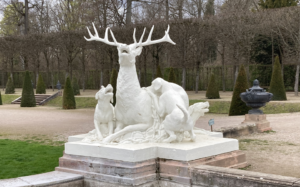
Schwetzingen Palace
Schwetzingen Palace, famous for the beauty and harmony of its gardens.
The original design, in all its diversity, survives to this day.
Schwetzingen Palace is located at the western end of the town of Schwetzingen. Over the centuries, an electoral residence developed here, consisting of a palace and a baroque or English garden. The origins of Schwetzingen Palace (Schloss Schwetzingen) date back to 1350, when a small moated castle occupied the site on the foundations of which the current complex was built. The course of the walls of the former castle can still be seen in the east façade of the palace. The front façade facing the town is largely based on the foundation walls of the medieval castle. The southern tower is also partially part of the moated castle
 The fortress came into the hands of the Counts Palatine, during which time the building suffered a great deal, especially in the 17th century and particularly during the Palatinate War of Succession, when it was badly damaged. The castle alone was highly favored by the princes, who were devoted to hunting, in the Hardtwald forests. The destruction in 1689, marked the birth of a second existence.
The fortress came into the hands of the Counts Palatine, during which time the building suffered a great deal, especially in the 17th century and particularly during the Palatinate War of Succession, when it was badly damaged. The castle alone was highly favored by the princes, who were devoted to hunting, in the Hardtwald forests. The destruction in 1689, marked the birth of a second existence.
Elector Johann Wilhelm commissioned alterations in 1697 and set about rebuilding the castle, which, while retaining the surviving substance, now became a palace in a contemporary Baroque style. The addition of two wings significantly increased its size. His successor Carl Philipp continued to ennoble Schwetzingen, elevating it to a summer residence. Finally, however, and from 1742 onwards, especially under the then heir to the throne Prince Elector Carl Theodor, the palace became the starting point of the colossal complex. For the Electoral Palatinate, times of the highest art were dawning, turning Schwetzingen Palace Park into a backdrop for summer court life that was second to none.
A work of genius
Schwetzingen Palace reached the height of splendour under the Prince Elector Carl Theodor. He instructed the leading landscape architects of the age to design the gardens, including Nicolas de Pigage and later Friedrich Ludwig von Sckell, with assistance from many renowned artists. From 1749 onwards, they created a masterpiece of rare beauty and rich variety. The central part of the gardens, including the Zirkelbauten (wings of the main building, which form a semi-circle), leafy avenues and a circular parterre, is laid out geometrically, with a focus on symmetry and order. In the late 18th century, an English-style landscape park was added to the Baroque garden – the Arborium Theodoricum, as it is called, is one of the earliest of its kind in Germany.
The exotic and ornamental
Schwetzingen Palace Gardens are a cultural heritage site of European significance: more than 100 sculptures are scattered throughout this wonderful, and at times surprising, landscape. An assortment of whimsical buildings lend an exotic touch. The Apollotempel (temple of Apollo), a small, round building, houses a statue of the ancient Greek god of light and the arts, playing the lyre. The Badehaus (bath house) is a summerhouse with its own garden, modelled on an Italian villa. And, most spectacularly, in the Türkischer Garten (Turkish gardens), there is a mosque designed by Nicolas de Pigage – the largest structure of its kind in a German garden. Ornamented with oriental details, the late-Baroque building was purely decorative and served no religious purpose.
The palace garden, which is unique in shape and size. It is one of the first English gardens in Germany. The huge gardens, together with the small palace and adjoining circular buildings, make for a long visit. Schwetzingen Palace Park is a must-see, especially in Spring during the cherry blossom and daffodil season.
